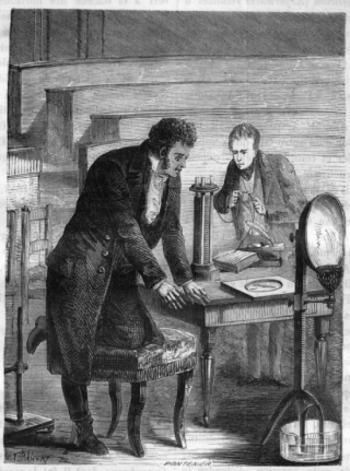When Oersted published the pamphlet detailing his discovery, he also proposed a theory to explain the phenomenon. In his model, there were two types of electricity (positive and negative) which combine to negate each other and are thus unobservable, and produce no electrical phenomena. However, they are constantly combining and recombining, and are therefore capable of producing other phenomena, namely magnetic phenomena. This concept of positive and negative electricity combining to negate each other is reminiscent of Franklin’s one-fluid theory of electricity.
Oersted proposed that a vortex-like, circular distortion existed around the wire, which he called the “electric conflict.” The conflict acts only upon magnetic particles, which experience a resistance to this conflict. When positive and negative electricity meet in a magnetic substance which offers resistance, they enter a new “state” wherein positive electricity attracts the North pole of the magnet, and negative the South. The electricities followed spiral paths through the wire according to the right hand rule. Thus, the magnetic needle deflects near a current-carrying wire. His theory is detailed in the pamphlet as follows:
“To the effect which takes place in this conductor and in the surrounding space, we shall give the name of the conflict of electricity…The electric conflict acts only on the magnetic particles of matter. All non-magnetic bodies appear penetrable by the electric conflict, while magnetic bodies, or rather their magnetic particles, resist the passage of this conflict. Hence they can be moved by the impetus of the contending powers.
It is sufficiently evident from the preceding facts that the electric conflict is not confined to the conductor, but dispersed pretty widely in the circumjacent space.
From the preceding facts we may likewise infer that this conflict performs circles; for without this condition it seems impossible that the one part of the uniting wire, when placed below the magnetic pole, should drive it towards the east, and when placed above it towards the west; for it is the nature of a circle that the motions in opposite parts should have an opposite direction. Besides, a motion in circles, joined with a progressive motion, according to the length of the conductor, ought to form a conchoidal or spiral line; but this, unless I am mistaken, contributes nothing to explain the phenomena hitherto observed.
All the effects on the north pole above-mentioned are easily understood by supposing that negative electricity moves in a spiral line bent towards the right, and propels the north pole, but does not act on the south pole. The effects on the south pole are explained in a similar manner, if we ascribe to positive electricity a contrary motion and power of acting to the south pole, but not upon the north.” –“Experiments on the Effect of a Current of Electricity on the Magnetic Needle,” Annals of Philosophy, October 1820
Despite the enthusiasm over his discovery of the needle’s deflection, there was no such enthusiasm for his accompanying theory. The electric conflict was vague and confusing, as was the manner by which it supposedly deflected the needle. Thus, the theory was generally dismissed. As L. Pearce Williams put it, “It must be confessed that this is not very clear. It is extremely difficult to visualize precisely what the electric conflict is and how it works. Furthermore, the vortex surrounding the wire cries out for explanation. What is it a vortex in? If it is matter, then how does the electric conflict put it in motion? If it is simply a rotating force, then how does this arise from the electric conflict?” (Williams, L. Pearce (1962) ‘Ampère’s electrodynamic molecular model’, Contemporary Physics, 4: 2, 113-123) Similarly, R.A.R Tricker says of the theory, “Its language is obscure. What was meant by the ‘electric conflict’ which was taking place outside the wire conveying a current, is very difficult to imagine. It was something in the nature of a vortex motion, to which most bodies offered no resistance. Magnetic substances offered resistance to it and were carried along by it in consequence. It is, however, difficult to see any reason why one end of a magnet should be carried in one direction and the other in the opposite direction on this view.” (Tricker, R.A.R., “Early Electrodynamics: The First Law of Circulation”, 1965, p22)
